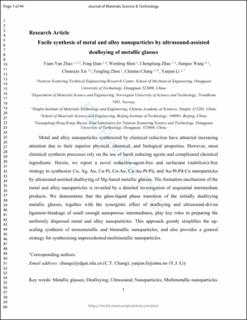| dc.contributor.author | Zhao, Yuanyun | |
| dc.contributor.author | Qian, Feng | |
| dc.contributor.author | Li, Yanjun | |
| dc.contributor.author | Shen, Wenfeng | |
| dc.contributor.author | Zhao, Chengliang | |
| dc.contributor.author | Wang, Jianguo | |
| dc.contributor.author | Xie, Chunxiao | |
| dc.contributor.author | Zhou, Fengling | |
| dc.contributor.author | Chang, Chuntao | |
| dc.date.accessioned | 2022-02-04T08:27:29Z | |
| dc.date.available | 2022-02-04T08:27:29Z | |
| dc.date.created | 2021-10-22T22:22:24Z | |
| dc.date.issued | 2021 | |
| dc.identifier.issn | 1005-0302 | |
| dc.identifier.uri | https://hdl.handle.net/11250/2977048 | |
| dc.description.abstract | Metal and alloy nanoparticles synthesized by chemical reduction have attracted increasing attention due to their superior physical, chemical, and biological properties. However, most chemical synthesis processes rely on the use of harsh reducing agents and complicated chemical ingredients. Herein, we report a novel reduction-agent-free and surfactant (stabilizer)-free strategy to synthesize Cu, Ag, Au, Cu-Pt, Cu-Au, Cu-Au-Pt-Pd, and Au-Pt-Pd-Cu nanoparticles by ultrasound-assisted dealloying of Mg-based metallic glasses. The formation mechanism of the metal and alloy nanoparticles is revealed by a detailed investigation of sequential intermediate products. We demonstrate that the glass-liquid phase transition of the initially dealloying metallic glasses, together with the synergistic effect of dealloying and ultrasound-driven ligament-breakage of small enough nanoporous intermediates, play key roles in preparing the uniformly dispersed metal and alloy nanoparticles. This approach greatly simplifies the upscaling synthesis of monometallic and bimetallic nanoparticles, and also provides a general strategy for synthesizing unprecedented multimetallic nanoparticles. | en_US |
| dc.language.iso | eng | en_US |
| dc.publisher | Elsevier | en_US |
| dc.rights | Attribution-NonCommercial-NoDerivatives 4.0 Internasjonal | * |
| dc.rights.uri | http://creativecommons.org/licenses/by-nc-nd/4.0/deed.no | * |
| dc.title | Facile synthesis of metal and alloy nanoparticles by ultrasound-assisted dealloying of metallic glasses | en_US |
| dc.type | Peer reviewed | en_US |
| dc.type | Journal article | en_US |
| dc.description.version | acceptedVersion | en_US |
| dc.rights.holder | This is the authors' accepted manuscript to an article published by Elsevier. Locked until 20/8-2022 due to copyright restrictions. The AAM is made available under the CC-BY-NC-ND 4.0 license http://creativecommons.org/licenses/by-nc-nd/4.0/ | en_US |
| dc.source.volume | 82 | en_US |
| dc.source.journal | Journal of Materials Science & Technology | en_US |
| dc.identifier.doi | 10.1016/j.jmst.2021.01.016 | |
| dc.identifier.cristin | 1947930 | |
| dc.relation.project | Norges forskningsråd: 309584 | en_US |
| cristin.ispublished | true | |
| cristin.fulltext | postprint | |
| cristin.qualitycode | 1 | |

